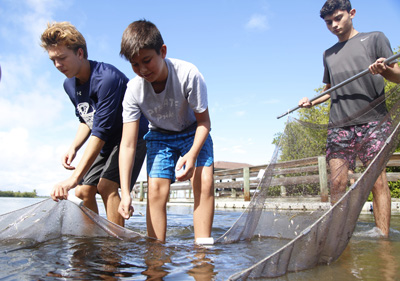
Seventh-grader Walter Lloyd waded waist-deep into the water at Vero Beach’s MacWilliams boat ramp last Thursday holding part of a seine net while several classmates helped. When they hauled the net onto the beach, they found anchovies, glass minnows and a baby snook in the mesh.
The students carefully recorded each creature they collected on log sheets, then released the minnows back into the Indian River Lagoon alive.
It was Walter – an avid fisherman and scuba diver – who identified the snook among the other little fish.
“I could tell by the black line and the way the mouth looked,” he explained, referring to the lateral line running the length of the little snook’s body.
Walter, a student at Gifford Middle School, was among some 1,600 elementary, middle and high school students from Volusia County south to Jupiter who spent last Thursday morning collecting water and sediment samples, measuring tide height and current speed, and counting fish along the entire 156-mile-long lagoon.
All were working as citizen scientists in the second annual “A Day in the Life of the Indian River Lagoon” – mentored by their teachers and a few hundred volunteer resource managers, scientists and environmental educators.
“They get in the water and collect the same information that research scientists do, but all along the lagoon and in a single day,” explained Missy Weiss of the non-profit Sea A Difference, who partnered with the Ocean Research and Conservation Association (ORCA) to organize the event. “This is not a one-and-done day field trip. We hope these partners will adopt these sites long-term for sampling.”
Weiss said all data collected will be uploaded to the seaadifference.org website and accessible to everyone. With a few more years of data, she said, student researchers will be able to compare biodiversity at their lagoon site with others’ sites and evaluate whether the lagoon is getting healthier or sicker.
A few miles south of MacWilliams boat ramp, 35 sixth-graders and 10 high schoolers gathered at the Saint Edwards School lagoon-front dock where an ORCA volunteer showed them how to measure dissolved oxygen, fecal coliform bacteria, and the nutrients nitrate and phosphorus in water samples. St. Ed’s senior Connor Jones tossed a couple of oranges into the water and demonstrated how to use them to measure the water’s current speed.
Sixth-grader Connor O’Brien was paying close attention.
“I like how different the currents can be in less than 30 minutes,” he said.
Several students were deploying a seine net in the water next to the dock – which they were unable to do at last year’s “A Day in the Life” due to a sighting of an alligator in the lagoon nearby.
Marine biology teacher Meghan Buckley said she would use the information the students collected in her lesson plans.
“For the marine students, they are going to compare the animals and water quality here with other sites in the lagoon,” Buckley said. “The marine kids are mentoring the younger ones. If you can get kids actively doing science rather than reading about it, it is really valuable.”
Further south at Round Island Park, 48 Vero Beach High School students waded in the lagoon and patrolled the shoreline collecting samples and performing tests under the supervision of environmental science teacher Nicole Mosblech and volunteers from the U.S. Fish & Wildlife Service.
“This kind of teaches students how we assess the quality of the ecosystem and what we do with the data to help fix it,” Mosblech said.



